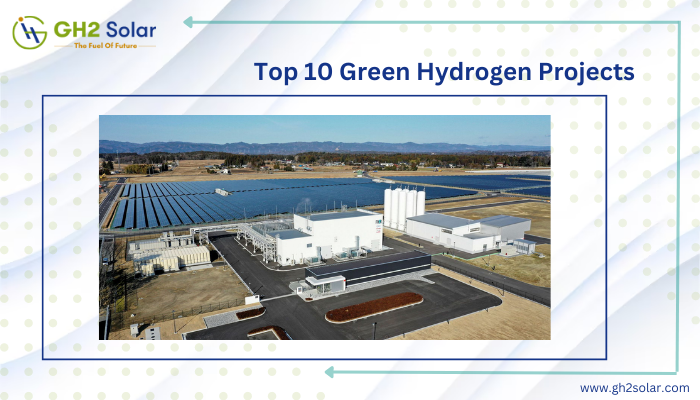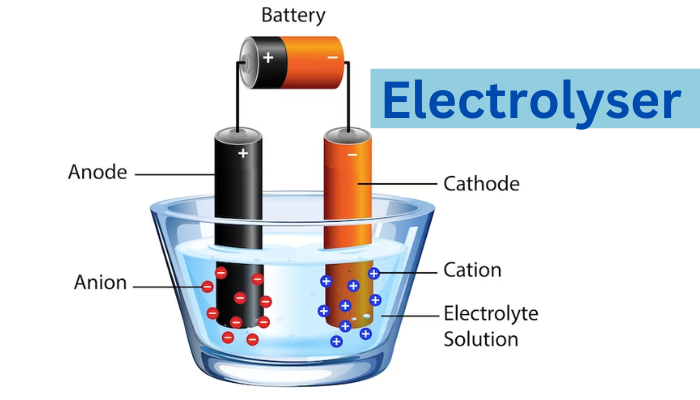In the search for renewable and clean energy, green hydrogen has emerged as a promising answer. Let’s look at the top 10 green hydrogen projects worldwide.
These projects serve as beacons of innovation, collaboration, and sustainability, showcasing the transformative capabilities of green hydrogen technology. From large-scale installations to cutting-edge research initiatives, these projects highlight the diverse approaches and achievements in the field of green hydrogen production and utilization.
Green hydrogen has drawn a lot of attention due to its potential to store and transmit clean energy effectively as the world moves towards decarbonization and renewable energy sources. Hydrogen and oxygen are separated from water molecules using electrolysis, which is powered by sustainable energy sources like solar and wind. This method emits no carbon emissions and has the enormous potential to replace fossil fuels in a variety of fields, including manufacturing, transportation, and power generation.
The global shift towards renewable energy sources has gained significant momentum in recent years as countries and industries seek sustainable alternatives to fossil fuels. Among the various solutions, green hydrogen has emerged as a crucial player in the transition to a cleaner and more sustainable energy future. Let’s explore the importance of green hydrogen in driving the renewable energy transition and its potential to reshape our energy systems.
- Versatile Energy Carrier: Green hydrogen, produced through electrolysis using renewable electricity, serves as a versatile energy carrier that can be used across multiple sectors. Its applications range from transportation and industrial processes to heating and electricity generation. By leveraging green hydrogen, renewable energy sources can be effectively integrated into sectors traditionally reliant on fossil fuels, reducing carbon emissions and environmental impact.
- Energy Storage and Grid Balancing: Renewable energy generation, such as solar and wind, is intermittent and dependent on weather conditions. Green hydrogen can play a pivotal role in energy storage, enabling the effective management of fluctuations in supply and demand. Excess renewable energy can be used to produce green hydrogen, which can then be stored and converted back to electricity or other forms of energy when needed. This enhances grid stability, supports a reliable power supply, and mitigates the challenges posed by intermittent renewables.
- Decarbonizing Hard-to-Abate Sectors: Certain sectors, such as heavy industry, aviation, shipping, and long-haul transportation, face significant challenges in decarbonization due to the limitations of current renewable energy technologies. Green hydrogen offers a viable solution by serving as a clean and sustainable fuel source for these hard-to-abate sectors. By substituting fossil fuels with green hydrogen, these industries can significantly reduce their carbon footprint and contribute to achieving climate targets.
- Emission-Free Mobility: The transportation sector is a major contributor to greenhouse gas emissions. Green hydrogen presents an opportunity for emission-free mobility, particularly in applications where electrification or battery technology may not be suitable, such as long-haul trucking, aviation, and marine vessels. Fuel cell electric vehicles powered by green hydrogen offer long-range capabilities, quick refueling, and zero tailpipe emissions, making them a promising alternative for a sustainable transportation future.
- Cross-Sector Integration: The integration of various energy sectors, including electricity, heat, and transportation, is crucial for an efficient and sustainable energy system. Green hydrogen acts as a bridge between these sectors, facilitating cross-sector integration and creating synergies. It enables the use of renewable energy surplus for hydrogen production, which can be further utilized in industrial processes, heating systems, and transportation, fostering a holistic and integrated approach to the renewable energy transition.
- Job Creation and Economic Opportunities: The growth of the green hydrogen industry presents significant economic opportunities, including job creation and technological advancements. The development, deployment, and scaling of green hydrogen projects require a skilled workforce and can stimulate local economies. Moreover, green hydrogen has the potential to transform countries into exporters of renewable energy, promoting energy independence and stimulating economic growth through the establishment of hydrogen value chains.
Throughout this blog, we will delve into each project’s location, scale, key players involved, the technology and processes utilized, as well as notable milestones and achievements. By examining these top green hydrogen projects, we aim to shed light on the progress made thus far and the pivotal role they play in shaping a greener and more sustainable future.
Here we see the top 10 green hydrogen projects worldwide with their capacity:
- HyDeal Ambition (67GW): This project in Europe plans to use 67GW of solar power to produce 3.6 million tonnes of green hydrogen per year for industrial and mobility sectors.
- Reckaz (30GW): This project in Kazakhstan aims to use 30GW of wind and solar power to produce 3 million tonnes of green hydrogen and 15 million tonnes of green ammonia per year for export to Europe and Asia.
- Western Green Energy Hub (28GW): This project in Western Australia intends to use 28GW of wind and solar power to produce 3.5 million tonnes of green hydrogen and 20 million tonnes of green ammonia per year for domestic and export markets.
- Aman (16-20GW): This project in Oman plans to use 16-20GW of solar power to produce 1.8 million tonnes of green hydrogen and 10 million tonnes of green ammonia per year for export to Europe and Asia.
- Green Energy Oman (14GW): This project in Oman aims to use 14GW of solar power to produce 1.75 million tonnes of green hydrogen and 10 million tonnes of green ammonia per year for export to Europe and Asia.
- Asian Renewable Energy Hub (14GW): This project in Western Australia plans to use 16GW of onshore wind and 10GW of solar power to produce 1.75 million tonnes of green hydrogen and 9.9 million tonnes of green ammonia per year for export to Asia.
- NortH2 (no less than 10GW): This project in the Netherlands plans to use offshore wind power to produce one million tonnes of green hydrogen per year for heavy industry in the Netherlands and Germany.
- AquaVentus (10GW): This project in Germany plans to use offshore wind power to produce one million tonnes of green hydrogen per year for domestic and export markets.
- Hydrogen Energy Supply Chain (HESC) (9.9GW): This project in Australia and Japan plans to use brown coal gasification and carbon capture and storage (CCS) to produce hydrogen for export to Japan.
- Neom (8.8GW): This project in Saudi Arabia plans to use solar, wind, and storage power to produce 650,000 tonnes of green hydrogen and 1.2 million tonnes of green ammonia per year for domestic and export markets.
These projects represent a diverse range of applications and advancements in green hydrogen technology. From large-scale industrial projects to innovative solutions for transportation and energy storage, each project demonstrates the potential of green hydrogen in transforming our energy landscape.
By implementing these projects, countries, and industries can significantly reduce their carbon footprint, decarbonize hard-to-abate sectors, enhance grid stability, and foster the integration of renewable energy across various sectors. Additionally, these projects are contributing to job creation, economic growth, and technological advancements in the green hydrogen industry.
The encouragement for further exploration and investment in green hydrogen is vital to unlocking its full potential and accelerating the global transition to renewable energy. By supporting research, development, and deployment of green hydrogen technologies, we can address climate change, enhance energy security, foster innovation, create job opportunities, and contribute to sustainable and resilient societies. Together, let us seize the immense opportunities presented by green hydrogen and shape a greener, cleaner, and more sustainable future for generations to come.
We At GH2 Solar
GH2 Solar a developer company for green hydrogen as well as solar projects that are set to revolutionize the energy industry. It’s cutting-edge technology and extensive experience in the field have enabled us to work with some of the biggest government companies to bring sustainable energy solutions to the market. If you are planning to adopt Green Hydrogen, you can connect with GH2 Solar to get all information about the same.
For more updates, follow us on Linkedin








